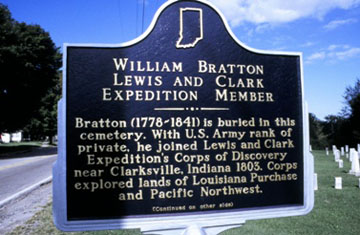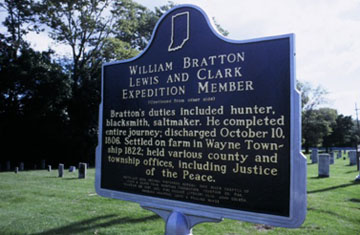

Location: East junction of US 136 & SR 25, Old Pioneer Cemetery, east edge of Waynetown. (Montgomery County, Indiana)
Installed: 2002 Indiana Historical Bureau and Ohio River Chapter of Lewis & Clark Trail Heritage Foundation, Fountain Co. DAR, Fountain Co. Hist. Soc., Pine Village Literary Club, John Culver, Barbara Haniford, Louis & Pauline McKee
ID#: 54.2002.1
Text
Side one:
Bratton (1778-1841) is buried in this cemetery. With U.S. Army rank of private, he joined Lewis and Clark Expedition's Corps of Discovery near Clarksville, Indiana 1803. Corps explored lands of Louisiana Purchase and Pacific Northwest.
Side two:
Bratton's duties included hunter, blacksmith, saltmaker. He completed entire journey; discharged October 10, 1806. Settled on farm in Wayne Township 1822; held various county and township offices, including Justice of the Peace.
Keywords
Early Settlement and Exploration, Cemetery
Annotated Text
Bratton (1778-1841) is buried in this cemetery. (1) With U.S. Army rank of private, he joined Lewis and Clark Expedition's Corps of Discovery near Clarksville, Indiana 1803. (2) Corps explored lands of Louisiana Purchase and Pacific Northwest. (3)
Bratton's duties included hunter, blacksmith, and salt maker. (4) He completed entire journey; discharged October 10, 1806. (5) Settled on farm in Wayne Township 1822, (6) held various county and township offices, including Justice of the Peace. (7)
1) Charles G. Clarke, The Men of the Lewis and Clark Expedition: a biographical roster of the fifty-one members and a composite diary of their activities from all known sources (Glendale, California, 1970), 43-45; Olin D. Wheeler, The Trail of Lewis and Clark, 1804-1904 (New York, 1926), 2: 112-14, 387.
2) Clarke, 43; Elliott Coues, History of the Expedition under the Command of Lewis and Clark (New York, 1893), 254.
"Born July 27, 1778, in Augusta County, Virginia . . . it is reported that William's family migrated to Kentucky about 1790, and on October 20, 1803, William enlisted under William Clark for the expedition. Hence he is usually listed as one of the "Nine young men from Kentucky." Clarke, 43.
3) Thomas Jefferson to Congress, January 18, 1803, in Donald Jackson, ed., Letters of the Lewis and Clark Expedition with Related Documents, 1783-1854, 2 vols. (Urbana, Ill., 1978), 1: 10-13; Gary Moulton, The Journals of the Lewis and Clark Expedition, Vols. 2-5, 8 (Lincoln, Nebraska, c1983-c1997); Stephen E. Ambrose, Undaunted Courage: Meriwether Lewis, Thomas Jefferson, and the Opening of the American West (New York, 1996).
4) Wheeler, Vol. 1, 114-16, 117-18; Clark 44-45.
"At an early age he was apprenticed to a blacksmith, possibly his father, or uncle, James, and later became an excellent gunsmith and blacksmith on the expedition. In these capacities, and as a hunter, he was a useful man." Clarke, 44.
5). United States Discharge Papers, October 10, 1806.
6) Montgomery County, Indiana, Original Entry Book, 1821-1836, Book 132, p. 532; Wheeler, 114-15.
"After his return from the Lewis and Clark exploration he lived for a time in Kentucky, and he was near New Madrid, Mo., at the time of the great earthquake in 1811. He was a soldier in the War of 1812, serving under Gen. Wm. Henry Harrison, was in the battle of Tippecanoe, saw Tecumseh after he was slain, and was one of those surrendered by General Winchester at Frenchtown, ”now Monroe,” Mich., in 1813. For several years before marriage he followed the milling business and then devoted himself to farming. He was married in 1819, lived for a time at Blowing Green, Ky., then moved, first to the vicinity of Terre Haute, and then to the neighborhood of Waynetown, Ind. He was the father of eight sons and two daughters." Wheeler, 114.
7) Clarke, 45; Montgomery County Commissioner's Records, Book No. 1, 1824.
